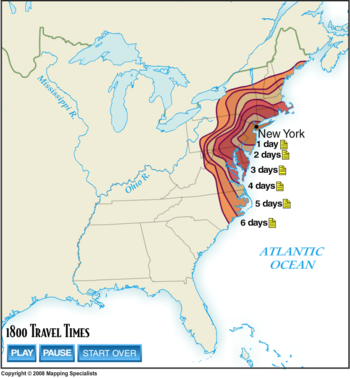UW-Madison spinoff is big-time producer of specialty maps
David Knipfer, owner of Mapping Specialists, with one of the company’s print-on-demand, large-format maps, which are produced under contract with publishers.
Photos: David Tenenbaum
You might think that Google, Garmin, Apple and MapQuest have driven a stake into the heart of paper maps. And indeed, the various gadgets that use global positioning satellites to give directions continue to proliferate.
But if paper maps are dead, nobody has read the obituary to David Knipfer, owner and operator of Mapping Specialists, a 15-person business in Fitchburg that runs the gamut from paper to digital.
The company, founded in 1984 by Onno Brouwer, director of the Cartography Lab in the University of Wisconsin–Madison Department of Geography, has produced maps for Rand McNally, National Geographic and the Adventure Cycling Association. It creates maps for textbook publishers and fire departments. And it supports print-on-demand production of single maps 60 inches wide at any length.
Knipfer, who has been with the business since 1986 and bought it in 2009, has seen waves of technological revolution in his chosen field.
Besides printed maps, Mapping Specialists creates digital maps for educational purposes. This one shows the time needed to travel various distances in the United States in 1800.
The last 30 years have been dominated by a procession of computer-generated map technologies, culminating in do-it-yourself mapping through handheld navigation devices, phones, tablets and computers.
The Cartography and Geographic Information Systems (GIS) program at UW–Madison has long been recognized as a world leader, so it’s no surprise to find a local offshoot with national impact. “There are probably three companies our size around the country that do contract mapping and that serve book and map publishers,” Knipfer says.
Jobs come from all directions. “Maybe they have something that they need to update or rejuvenate, or they want to expand a line that is already created, which already has a design attached,” Knipfer says. “For educational publishing — history and geography texts, for example — we have a multitude of databases we have created of different regions at different scales and levels of detail.”
If Mapping Specialists is developing a population density map for a college text, “the author may have a specific set of data for the map and we will drape it over a design based on one of our databases,” Knipfer says.
Accurate maps depend on accurate data correctly formatted, Knipfer says. “Maybe it’s accurate, but it’s formatted incorrectly, or there is some error that you don’t recognize until you drop it into something that’s geographically accurate.”
Mapping Specialists, along with the rest of the industry, can deliver digital maps — essentially streams of data that can be “dropped into” websites, mobile apps and the like.
David Knipfer with a selection of the maps his company has produced.
But there is also plenty of action on paper. “We are seeing a rejuvenation of certain types of printed maps, especially specialized maps,” says Knipfer. “Consumers are starting to learn that you can’t rely on GPS to always be alive, active. Cycling represents the type of activity where people still want a waterproof, printed map. If you’re on a five-day hike, a paper map is insurance that you’ll be able to get yourself out.”
Paper road atlas sales also remain strong, he says. “People like to have something they can sit down with to plan their trip. For the trip itself they may rely on a phone or other navigation device in the vehicle, but they do like to have the big picture: where am I starting, where am I going and what should be in between.”
Increasingly, users are entering their own data — especially photos — into maps on portable devices, creating what’s called a geo-PDF. “Adding data points is nothing new, but it’s becoming more robust,” says Knipfer. “Consumers can use their phone as a camera-GPS device and tie their pictures to a geographic location. Taking a picture and dropping it into a location is a neat way for people on a tour to create a geographically accurate digital archive: ‘Here’s the location of that great restaurant we ate at in Tuscany … and here’s the view from the patio.'”
Today’s technology is light years ahead of the four-inch stack of punch cards that were used to map the United States in the archaic Fortran computer language when Onno Brouwer started Mapping Specialists, but Knipfer is savvy enough to know that another technological revolution must be lurking around the corner. And for that, he relies on expertise from the Cartography Lab that first spawned his business 31 years ago.
Tags: business, cartography, geography, spinoffs





